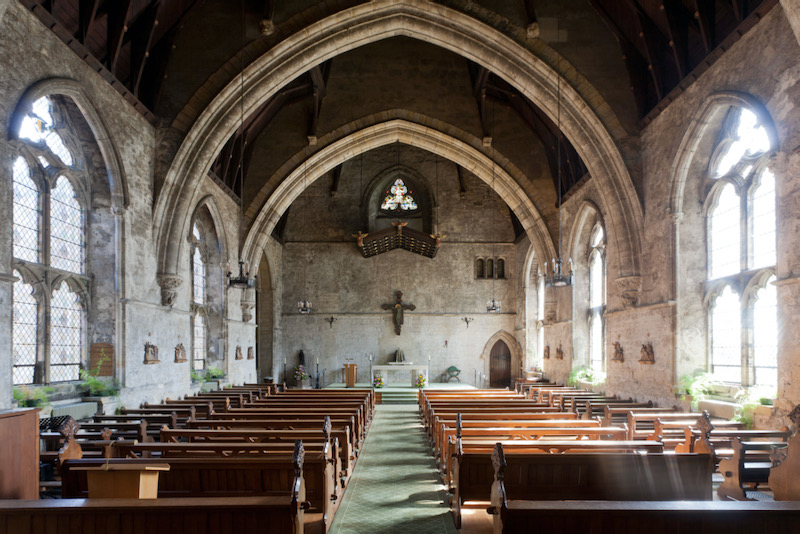Cornelia Connelly’s name has made headlines across national media in 2021 just as it did between 1848 and 1851. The mid-Victorian cause célèbre, involving Pierce Connelly’s legal attempt to restore his conjugal rights over her, has been well-rehearsed elsewhere in The Tablet, and many of those commenting on the dispute over exhumation of her bodily remains from the chapel in Mayfield Sussex, a plan that has now been withdraw but had planned for re-interment of some of the remains in Philadelphia’s Catholic cathedral, have made this connection. The interest in Cornelia Connelly and the emotions aroused on both occasions have their engaging elements for those simply scanning the news. But the interest and emotions are also a prompt to explore the full significance of this Victorian wife, mother, religious founder and educator in the history of Catholicism.
Catholic sisters belonging to a new style of active religious institute were to become major actors in the nineteenth-century Catholic revival across Europe and North America. This movement of women to renew the Church and reinvigorate people’s faith through parish service, educational activity, sacramental and devotional life began in France and Ireland in the 1790s. Women of Francophone Europe were innovators and initiators in this movement and Ireland, with its diasporic “spiritual empire”, contributed both female leadership and countless working lives to the Church’s mission in the English-speaking world. In England only a handful of small convents of apostolic or active sisters were present in 1830, almost all of these belonging to Irish or Francophone congregations which had sent sisters on mission (O’Brien, 1988).
As founder of the Society of the Holy Child Jesus (SHCJ) Cornelia Connelly had a significant role in the evolution of active religious life for women in England. Her Society was one of the new type of women’s congregations and can legitimately claim to the first such to be founded in England itself since the Reformation. Yorkshire-born Mary Ward had founded the pioneering unenclosed Institute of the Blessed Virgin Mary in the early seventeenth century, but in the Low Countries not England. Some Mary Ward sisters came to England and (illegally) opened convents in York and Hammersmith in the late seventeenth century, but her Institute was strongest outside of England. Margaret Hallahan founded the Third Order Dominicans in Coventry in 1845, the year before SHCJ, and while it could be argued this was the first new foundation in England, the sisters belonged within a long tradition of Third Order Dominicans who were not “new”, either in a spiritual sense or in their form of governance. SHCJ was the first in England of the new type of active women’s education congregations with its own spirituality and a centralised form of governance capable of becoming transnational under the authority of its Mother General.
Cornelia Connelly had intended her new foundation for America not England, and she did not give up on her idea of a mission to America or, indeed, wider even than that. But obedient to the wishes of Pope Gregory XVI, himself influenced by the English Catholic lobby in Rome in the early 1840s (which included Bishop Wiseman), she accepted that England should be her first educational and spiritual mission field. As an “Anglo” (as they saw her) with informed modern ideas about girls’ education and herself a convert, Connelly was seen as intuitively sympathetic to English Catholics and the needs of the daughters of English converts to Catholicism, and so it proved. English vocations from the boarding schools were high (Mangion, 2009, 84) and the society had a higher-than-average proportion of English-born members. (Mangion 2009, 191) But as early as 1862 she also fulfilled her early hopes by making her first American foundation and then extended into France.
The education offered by SHCJ under Mother Connelly’s leadership has claims to originality. She wrote and published the Book of the Order of Studies for use across the Society’s schools. Its distinctiveness lay in the way it blended an understanding of child development (possibly influenced by her experience of motherhood) and existing Ignatian pedagogy with Mother Connolly’s own emphasis on practical learning and creativity. She founded the Holy Child Theatre (against episcopal criticism) where the girls made all the scenery and costumes as well as directing and performing (O’Brien, 2014).
As part of an art education described by one scholar as beyond what was taught in art colleges of the day (Marmion, 1984), she taught architectural drawing and a wide range of ‘making’ such as sculpture, encouraging independence of thought among pupils and trust of young people by teachers (O’Brien, 1988). The fact that the Society established fee-paying boarding and day schools for the Catholic middle-classes and also taught in parish elementary free schools in deprived areas is not unusual for a religious congregation; indeed, the Society had fewer schools than a number of other congregations, such as the Sisters of Notre Dame de Namur or the Sisters of Mercy. It was the quality of education and the pedagogical approach, recognised by school inspectors at the time but not acknowledged in English histories of education, which is of note (Marmion, 1984). Mother Connelly’s educational legacy shows through in the Society’s unbroken championing of girls’ education; its opening of a house of studies in Oxford for sisters and other women students (first SHCJ graduate 1907); its higher education colleges in America and Nigeria which thrive to this day; and the continuing centrality of the creative and performing arts as an important pedagogical vehicle across all the Society’s schools.
Through her community, schools, and the involvement of the wider Catholic community of parents and friends, Cornelia Connelly was a female leader within the Catholic revival who enriched the spiritual lives of others. She demonstrated an unusually confident grasp of the dynamic in Catholic liturgy and of the importance of material culture and embodiment to spiritual life and devotional practice. (McCarthy, 1986; O’Brien, 2014) Sisters and pupils used Pugin’s copy books to make liturgical vestments, illuminated manuscripts, banners and chapel carpets to a high standard. The convents created indoor and outdoor tableaux for processions on major sacred feasts and at Christmas Mother Connolly instituted a tradition of “live crib” complete with pupil-actors and a real donkey. Choirs were trained and music for Mass was carefully planned.
Within the framework of the Church’s liturgical calendar was embedded a Holy Child liturgical calendar honouring the feasts of special significance to the Society: Epiphany and the Feasts of the Sacred Heart and of St Walburga and St Philomena, for example. It is within this overall liturgical context that we understand Cornelia Connelly’s collaboration with EW Pugin for the fine chapel at St Leonards in Sussex (Jordan, 2015). Her restoration of the medieval palace of the archbishops of Canterbury at Mayfield for use as chapel, school and convent, again employing quality architects, occupies an important place among Catholic retrievals of other medieval buildings, such as the rebuilding of Buckfast Abbey and the Marian shrine at Walsingham, “lost” at the Reformation and significant to the forging of a renewed Catholic identity in Victorian England. (Jordan, 2015)
Cornelia Connelly’s approach to leadership and pedagogy in the Society drew its creative and innovative authority from her upbringing and life as an American. She also learned much as a Catholic from her time in Rome, becoming familiar with St Peter’s and the Catacombs, studying with the German Nazarene school of Christian art based there. The English Catholic revival benefited from such multi-layered and transnational influences as these. But Connelly’s deepest spiritual insights and influence derived from the ways she found to integrate the pain of loss into a life lived with purposeful joy for God and others – there’s the real headline.
The archives of the SHCJ held at their convent in Oxford are a fully catalogued resource for scholars. Because the Society prepared Positio documentation for Mother Connelly’s canonisation cause, a great deal of the archival material is available as verified typescripts. Much material has been digitised by the American Province and made available online at https://corneliaconnellylibrary.org
Select bibliography
Jordan, Kate ‘Ordered Spaces, Separate Spheres: Women and the Building of British Convents, 1829-1939’ (PhD thesis, University of London, 2015)
Lancaster, Judith shcj Cornelia Connelly and Her Interpreters (London, 2004)
McCarthy, Caritas shcj The Spirituality of Cornelia Connelly (Lewiston, 1986)
Mangion, Carmen Contested Identities: Catholic women religious in nineteenth-century England and Wales (Manchester, 2008)
Marmion, J. ‘Cornelia Connelly’s Work in Education’ (PhD thesis, University of Manchester, 1984)
O’Brien, Susan ‘With a mother’s imagination: Ignatian spirituality in the Society of the Holy Child Jesus’ in Silvia Mostaccio ed.,
Dr Susan O'Brien is a Senior Member of St Edmund's College, Cambridge. Her research into the history of women religious in modern Britain began 35 years ago in the archives of the Holy Child Jesus and her most recent publication is “Leaving God for God: Daughters of Charity in Britain” 1847-2017 (DLT).
This article is an adapted version of a piece written for the Historic Churches Commission and English Heritage, published on the HCC website on 26 February.



 Loading ...
Loading ...
What do you think?
You can post as a subscriber user ...
User comments (0)